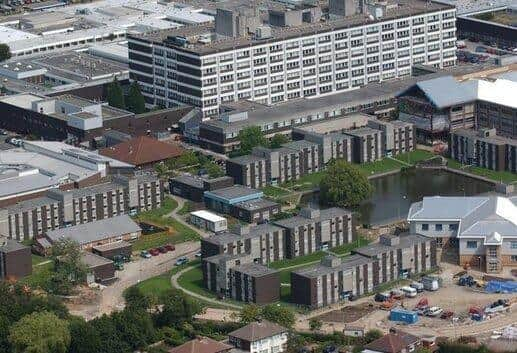Covid autumn booster vaccine: figures suggest 'lack of interest' among middle aged in Preston, South Ribble and Chorley last year, as new rules remove the option altogether in 2023
and live on Freeview channel 276
It was not until the 60-64 age bracket that more than half of Prestonians accepted the vaccine offer in 2022 - and only amongst the over-70s that all three Central Lancashire districts saw take-up levels of 75 percent or more.
The data paints a picture of middle-aged disengagement from the area's vaccine programme long before this week's government decision to put boosters out of reach for the majority of under-65s - irrespective of whether they would choose to have one or not.
Advertisement
Hide AdAdvertisement
Hide AdLancashire's public health boss says that vaccinations are still the best protection against the virus - and urged those who are eligible for a top-up jab this year to take up the opportunity.


Age-related eligibility for an autumn Covid booster will begin at 65 this year - compared to just 50 in 2022. The same policy shift had already been announced for the annual flu vaccine, marking a return to the pre-pandemic criteria for that jab.
Unlike with the flu shot, however, people who are ineligible for a Covid booster on the NHS this year will not be able to pay for one.
Meanwhile, figures have revealed that more than a quarter of Royal Preston and Chorley Hospital patients who tested positive for Covid last year definitely or probably caught the virus while they were on the wards.


Advertisement
Hide AdAdvertisement
Hide AdThe statistics were presented to a board meeting of Lancashire Teaching Hospitals NHS Foundation Trust (LTH), which was told that the layout and age of its estate made it more difficult to prevent so-called “nosocomial” infections than in otherwise similar facilities.
LTH chief executive Kevin McGee told the Lancashire Post earlier this year that a combination of pressures made last winter “the worst…that the NHS [had] ever seen” - and that was against the backdrop of broader access to Covid and flu vaccines than will be the case in 2023/24.
Between April 2022 and March this year, 2,878 trust patients tested positive for Covid. The general trend has been for people to be in hospital coincidentally with the virus, rather than because of it - but the point at which LTH patients first recorded a positive result reveals whether they were likely to have contracted it before or after admission.
According to LTH’s annual infection prevention and control report, 457 Covid patients could only have caught the virus while they were in hospital, while in another 360 cases it was “probable” that they did so. Combined, that means that 28 percent of patients who had Covid during their hospital stay were likely to have picked it up while they were there.


Advertisement
Hide AdAdvertisement
Hide AdThere were also hospital-onset flu cases at the Preston and Chorley sites last winter, but in far lower numbers - fewer than 150.
The document declares that the trust suffers from “key disadvantages” compared to others when it comes to stemming the spread of what are known as "nosocomial infections" - those contracted in hospital.
It details how a “large number” of LTH bays have “virtually no ventilation” and refers to the fact that Covid “spreads more readily in poorly ventilated areas” - an acknowledgement of the predominantly airborne nature of the virus’ spread, which has been a less prominent feature Covid public health messaging since the move to the so-called ‘living with it’ phase of the pandemic.
Only 20 percent of the beds across the Preston and Chorley hospital sites are located in side rooms, making it difficult to segregate patients - one of the arguments that was advanced when the NHS in Lancashire made the case for the recently-approved new Royal Preston, which is to be built in the early 2030s. Maintenance of a two-metre separation distance between beds is also impossible in most areas of the LTH estate.


Advertisement
Hide AdAdvertisement
Hide AdThe infection report states that “the rise in influenza cases, along with Covid-19...proved difficult in terms of capacity and isolation”. That meant that patients with the same infection had to be “cohorted” together in many instances, rather than segregated.
LTH had continued to require masking in all clinical areas throughout the 2022/23, spanning a period between last summer when the precaution was ditched at a national level. The trust only stopped requiring face coverings in most of those settings on 24th April this year - and still does so in areas where known Covid patients are being treated.
Nationwide, there has been a recent increase in Covid cases - albeit from a relatively low base - believed to be driven by the new “Eris” variant which has emerged in the UK in recent weeks and already accounts for one in 10 infections.
The number of people in hospital with Covid - but, again, not necessarily because of it - is also rising, almost doubling between the first and and final weeks of July to stand at 1,438 patients, according to government figures.
Advertisement
Hide AdAdvertisement
Hide AdAt LTH as of Tuesday, there were eight Covid patients - a figure that has shown no significant change in recent weeks and is far below the peak so far in 2023, when a figure of 104 was recorded on 15th March.
However, the massively reduced level of testing in the community - and even in hospital settings - means that actual infection rates are likely to be higher than official figures suggest. The Office of National Statistics’ (ONS) Covid infection survey, which regularly sampled the same 180,000 people to estimate the percentage of the population with the virus, was also scrapped back in March, removing another layer of surveillance data.
An estimate derived from the ZOE Health Study app, via which people can self-report symptomatic Covid cases, indicates that there were just over 819,000 infections nationwide as of 7th August - a 33 percent increase on the prediction produced by the study a month earlier. Official data suggests that only just over 4,000 people tested positive in England between 23rd and 29th July.
Speaking just before the announcement of the revised eligibility criteria for this year’s autumn booster, Lancashire County Council's director of public health, Dr. Sakthi Karunanithi, told the Post that vaccination “remains our best defence against Covid-19, so it is still important that people take up all the doses they are eligible for as soon as possible”.
Advertisement
Hide AdAdvertisement
Hide AdHe added: "It is also important that people continue the safe practices reinforced throughout the pandemic such as regular and thorough hand washing, which helps protect you from Covid-19 and other bugs and viruses.
"The NHS will be in contact in the autumn when the seasonal vaccine is available for those who are eligible, and I urge everyone who is offered to take up the vaccine when offered.
"I would also urge parents to check that their child's vaccinations are up to date as we anticipate an increased risk of rising measles cases as summer draws to a close and schools reopen," Dr. Karunanithi said.
While Covid vaccinations usually offer lasting protection against severe disease and death, the prevention of infection can be measured in a few short months.
Advertisement
Hide AdAdvertisement
Hide AdAlthough the acute phase of a Covid infection is much less serious for most people than it was in the pre-vaccine era, groups including the clinically vulnerable, immunocompromised and older ages are still at greater risk. The government's Immunisation Green Book notes that the risk of "poorer outcomes" from Covid infection increases dramatically with age in both healthy adults and [those] with underlying health conditions".
Across England in the week to 7th July, Covid was mentioned as a factor on the death certificates of 63 people - down from the hundreds of such instances being recorded each week earlier this year, during periods of greater virus prevalence.
Even younger, healthier people who contract Covid - with or without symptoms could still suffer adverse consequences after their apparent recovery.
The World Hospital Organisation (WHO) estimates that between 10 and 20 percent of those infected with the virus go on to suffer the debilitating collection of symptoms known as Long Covid, which can include extreme fatigue and cognitive problems. Just last month, a study researchers at King’s College London concluded that the so-called “brain fog” associated with Long Covid is akin to ageing by a decade.
Advertisement
Hide AdAdvertisement
Hide AdAccording to the ONS, at the start of this year, an estimated two million people were experiencing self-reported Long Covid - classed as symptoms which had continued for at least four weeks after confirmed or suspected infection.
Of those, 61 percent had been infected at least one year earlier - with symptoms ongoing ever since - while for 35 percent of Long Covid sufferers, their infection had come at least two years previously. The WHO estimates that as many as 1 in 30 Europeans are finding it difficult “to return to normal life.” because of the condition.
Notwithstanding the chance of developing Long Covid, studies have also shown an increased risk of heart attack and stroke after Covid infection.
WHO CAN HAVE A BOOSTER THIS YEAR?
Following a recommendation by the Joint Committee on Vaccination and Immunisation (JCVI), the government will not offer a Covid autumn booster jab to all 50-64-year-olds this year - although some people in that age group will still qualify for other reasons.
Advertisement
Hide AdAdvertisement
Hide AdIt had already been announced that a free flu vaccine would be offered only to the over-65s this winter - in a return to the pre-pandemic arrangements.
The over-75s and some other groups were also offered a spring booster earlier this year.
The eligible groups for the Covid autumn booster in 2023 are:
***all adults aged 65 years and over
***residents in care homes for older adults
***frontline health and social care workers
***those aged between six months and 64 years who are in a clinical risk group, as defined in the government’s Immunisation Green Book - including diabetics and those suffering from chronic respiratory, heart and liver diseases.
Advertisement
Hide AdAdvertisement
Hide Ad***carers aged 16 to 64 years and staff working in care homes for older adults
***those aged 12 to 64 years who are household contacts of people with immunosuppression
Commenting on the revised rules, Professor Wei Shen Lim, chair of Covid-19 immunisation on the JCVI, said: “The autumn booster programme will continue to focus on those at greatest risk of getting seriously ill. These persons will benefit the most from a booster vaccination.
“It is important that everyone who is eligible takes up a booster this autumn – helping to prevent them from hospitalisations and deaths arising from the virus over the winter months.”
Advertisement
Hide AdAdvertisement
Hide AdDr Mary Ramsay, director of public health programmes at the UK Health Security Agency (UKHSA), added: “The COVID-19 virus has not gone away and we expect to see it circulating more widely over the winter months with the numbers of people getting ill increasing.
“The booster is being offered to those at higher risk of severe illness and by taking up the booster vaccine this autumn, you will increase your protection ahead of winter, when respiratory viruses are typically at their peak.”
TESTING TIMES
While Covid testing was once seemingly ubiquitous - and a requirement in many scenarios - it has been dramatically scaled back over the last 18 months, as the perceived threat from the virus has declined.
Free lateral flow tests for the general public were withdrawn in April 2022 and that move has since been followed by reductions in testing even in many health and care settings.
Advertisement
Hide AdAdvertisement
Hide AdIn August last year, routine asymptomatic testing was scrapped in hospitals and care homes for staff and patients or residents.
This spring, routine symptomatic testing of staff, patients and residents in care settings, prisons and refuge shelters was also jettisoned.
The Post understands that the guidance for symptomatic patient-facing hospital staff is for them to stay away from work if they have respiratory symptoms and a high temperature. They should only return once they are feeling well and their temperature has settled - but they do not need to take a test beforehand.
NHS staff with Covid symptoms who work on inpatient wards with severely immunosuppressed patients are expected to continue to test and must stay off work for at least five days, returning only after two negative lateral flow tests, taken 24 hours apart. In the case of the Royal Preston, the Post understands that the areas operating under those rules are ward 25 and Ribblesdale ward.
Advertisement
Hide AdAdvertisement
Hide AdTesting also continues for staff with symptoms who work in hospices and all patients being discharged from hospitals into care settings.
It also remains available for symptomatic individuals who are eligible for Covid-19 treatment, as a result of their vulnerability, in order to enable rapid access to that medication.
WHO GRABBED A JAB LAST YEAR?
Preston
50-54: 32.6 percent
55-59: 45.5 percent
60-64: 55.7 percent
65-69: 66.2 percent
70-74: 74.7 percent
75-79: 79.1 percent
80-84: 78.7 percent
85-89: 80.6 percent
90+: 78.2 percent
South Ribble
50-54: 41.9 percent
55-59: 53.8 percent
60-64: 65.0 percent
65-69: 76.4 percent
70-74: 81.8 percent
75-79: 86.0 percent
80-84: 86.6 percent
85-89: 86.2 percent
90+: 86.9 percent
Chorley
50-54: 40.3 percent
55-59: 51.6 percent
60-64: 62.4 percent
65-69: 75.5 percent
70-74: 80.7 percent
75-79: 84.4 percent
80-84: 83.8 percent
85-89: 84.0 percent
90+: 81.2 percent
Source: gov.uk
